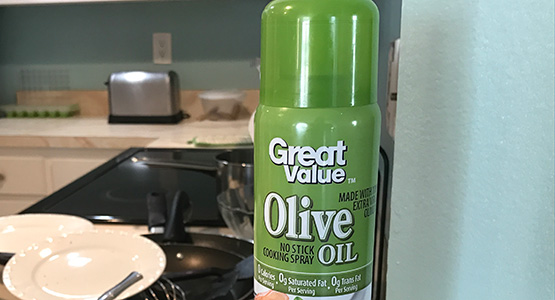Olive oil spray. It seems innocent enough, if not ingenious. A healthy type of oil packaged in a convenient spray can. It has few—if any—calories. No saturated or trans fats (as most labels prominently claim). It’s ultra-easy to use and less messy than oil from the bottle. And its precise, mist-like sprayer ensures minimum waste for maximum value.
Why Think Twice?
How could there be a downside to an oil spray? Here are a few things to consider:
Questionable Ingredients
For starters, look at the list of ingredients. Precious few of the sprays on the market list extra virgin olive oil as the only ingredient. The rest include additives like these:
- Soy Lecithin is typically classified as a “non-stick agent” although it is also an emulsifier. It is made from what remains after oil has been extracted from soybeans (usually GMO soybeans). This “gunk” is separated into lecithin (fatty acids) using a centrifuge. From there, it is bleached with hydrogen peroxide once or twice before undergoing a final acetone extraction process.
- Dimethyl Silicone is an anti-foaming agent. Its viscosity enables it to have many uses beyond cooking spray. For example it is used in glues, furniture polish, textile finishing, shock absorbers, rust prevention and water repellant for cement. Enough said.
- Propellants are gases used to drive the fluid out of the can when you press down on the sprayer. A commonly used propellant is a combination of petroleum gas, propane and butane. The list could also include gases like nitrous oxide, carbon dioxide and isobutene. The FDA considers most olive oil spray propellants “Generally Recognized As Safe.” One thing to keep in mind—where do these gasses go when you spray?
Split-Second Serving Size
In the U.S., if a product contains less than 0.5 grams of fat per serving, producers can “round down” and list it as having 0 grams on the label. Most sprays measure serving size by the length of time the sprayer is depressed. For example, a common serving size is a 1/3 second spray. (Yes, a fraction of a second.) That adds up to about .25 grams of fat, which can be listed as 0 grams. And since the calories in oil spray come from fat, the calorie count can go to zero as well. So…if you would like to coat a pea, and have the finger dexterity to do so in a split second, you can achieve what the label specifies.
High Heat
With the spray can, the olive oil is denatured. To enable a standard product (that always tastes the same) at the least cost, manufacturers typically purchase from many different sources and process the oil at a very high heat for uniformity. Factor in the ongoing issues with adulterated olive oil, and the health benefits of this product certainly come into question.
Enter Ayurvedic Reason
Olive oil is a vital part of the Mediterranean diet, which is considered “heart healthy” by conventional research. Ayurveda understands that the benefits of olive oil come from how it is used as part of a traditional diet:
- Cold pressed: As part of an indigenous diet, olive oil is always cold pressed and unrefined. It is squeezed from the olives without the use of heat. This contributes to its “heart healthy” qualities. Heating oils to high temperatures enables the formation of free radicals. It also destroys the nutrients and phytochemicals that make that oil so healthy in the first place.
- Healthy fat: Dietary fats play a critical role in maintaining alignment. Beyond giving the body energy, they help to support cell growth, nutrient absorption and hormone production. Fats protect your organs and assist brain and nervous system functioning. Olive oil is not just a fat, it is a non-saturated fat. This puts a double check in the “good for you” category.
- Calories: From an Ayurvedic perspective, calories are not the issue. In nature, calories equal nourishment and energy for the body. They are the basis of life itself. In the appropriate measure, calories are considered good for you.
- Bitter taste: Taste plays a critical role in maintaining alignment. It is representative of the nutrients and phytonutrients in our food, and triggers many biological processes in the body. Olive oil has a bitter taste, which Ayurveda associates with being cooling and cleaning. The bitter quality helps to reduce inflammation (the root cause of heart disease) and, among other things, cleanses the liver of fat and toxins. Denaturing oil eliminates all these benefits.
Back to the Spray Can
Is it worth it? The denaturing process has probably created free radicals and eliminated the health benefits that attracted you to the oil in the first place. Plus, the addition of chemicals has unknown effects. Does convenience override the consequences of using an olive oil spray? Probably not.
What would Ayurveda recommend? Buy a reputable (hopefully organic) cold pressed extra virgin olive oil. Shy away from cooking with it (especially at high temperatures). And if you love the convenience of cooking spray, simply opt for a sprayer like Misto, which you can fill yourself.
Problem solved.


